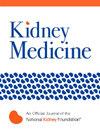Plasma and Urine Metabolites Associated With Nondiabetic Chronic Kidney Disease: The HELIUS Study
IF 3.4
Q1 UROLOGY & NEPHROLOGY
引用次数: 0
Abstract
Rationale & Objective
We aimed to find predictive plasma and urine metabolites for nondiabetic chronic kidney disease (CKD), and to validate these biomarkers in a diabetic kidney disease (DKD) population, using data of the population-based multiethnic Healthy Life in an Urban Setting study.
Study Design
Cross-sectional metabolome study.
Setting & Participants
From the Healthy Life in an Urban Setting population-based cohort, we included 124 participants with nondiabetic CKD, 45 with DKD and 200 healthy controls.
Predictors
Plasma and urine metabolites were measured using ultra-high-performance liquid chromatography coupled to tandem mass spectrometry (LC-MS/MS) with an untargeted approach.
Outcomes
(Nondiabetic) CKD.
Analytical Approach
We used machine learning models to predict nondiabetic CKD from metabolite profiles and used logistic regression models with adjustment for potential confounders to verify our results in the best predicting metabolites. In addition, we assessed the associations between the best predicting metabolites and DKD.
Results
Urine metabolites were more predictive of nondiabetic kidney disease than plasma metabolites. In plasma, the best predicting metabolites for nondiabetic CKD included many amino acids, including N-acetylated amino acids, histidine, and indolepropionate. In urine, the highest-ranked metabolites were predominantly lipids, including sphingomyelins and phosphatidylcholines. There was limited overlap among the top-ranked metabolites in predicting nondiabetic CKD between plasma and urine. Almost all associations with nondiabetic CKD could be translated to DKD. No interactions were observed with ethnicity.
Limitations
The cross-sectional design limits causal inference.
Conclusions
Our analyses revealed that urine metabolites were strongly associated with CKD than plasma metabolites in this multiethnic population. The finding that specific associations of plasma and urine metabolites could be translated to subjects with DKD suggests a shared pathophysiological background.
Plain Language Summary
Chronic kidney disease (CKD) has a rising incidence, yet its underlying causes are not fully understood. Using the multiethnic Healthy Life in an Urban Setting study, we explored which molecules in blood and urine (metabolites) are different in patients with CKD with albuminuria and preserved estimated glomerular filtration rate. Urine metabolites, particularly lipids like sphingomyelins, were more strongly associated with CKD than plasma metabolites, which included amino acids such as histidine and indolepropionate. These findings were also applicable to patients with diabetic kidney disease, suggesting shared disease mechanisms. Our study suggests that metabolomics may help identify metabolic changes linked to CKD and DKD and sheds new light on potential pathogenic pathways.
血浆和尿液代谢物与非糖尿病性慢性肾病相关:HELIUS研究
基本原理及目的:我们旨在寻找非糖尿病性慢性肾脏疾病(CKD)的预测血浆和尿液代谢物,并利用基于人群的多民族城市健康生活研究数据,验证这些生物标志物在糖尿病性肾脏疾病(DKD)人群中的有效性。研究设计横断面代谢组研究。设置,来自城市人群健康生活队列的参与者,我们纳入了124名非糖尿病性CKD患者,45名DKD患者和200名健康对照者。预测:采用超高效液相色谱-串联质谱(LC-MS/MS)非靶向方法测量血浆和尿液代谢物。我们使用机器学习模型从代谢物谱预测非糖尿病性CKD,并使用调整潜在混杂因素的逻辑回归模型来验证我们预测代谢物的最佳结果。此外,我们评估了最佳预测代谢物与DKD之间的关系。结果尿代谢产物比血浆代谢产物更能预测非糖尿病性肾病。在血浆中,预测非糖尿病性CKD的最佳代谢物包括许多氨基酸,包括n -乙酰化氨基酸、组氨酸和吲哚丙酸酯。在尿液中,排名最高的代谢物主要是脂质,包括鞘磷脂和磷脂酰胆碱。血浆和尿液在预测非糖尿病性CKD方面的代谢物有有限的重叠。几乎所有与非糖尿病性CKD的关联都可以转化为DKD。没有观察到与种族的相互作用。局限性横断面设计限制了因果推理。结论在该多民族人群中,尿代谢物与CKD的相关性强于血浆代谢物。血浆和尿液代谢物的特异性关联可以转化为DKD患者,这表明两者具有共同的病理生理背景。慢性肾脏疾病(CKD)发病率不断上升,但其根本原因尚不完全清楚。通过多民族城市环境下的健康生活研究,我们探讨了CKD伴蛋白尿患者血液和尿液中的哪些分子(代谢物)不同,并保留了估计的肾小球滤过率。尿液代谢物,尤其是鞘磷脂等脂质,与血浆代谢物(包括组氨酸和吲哚丙酸等氨基酸)相比,与CKD的相关性更强。这些发现也适用于糖尿病肾病患者,提示有共同的发病机制。我们的研究表明,代谢组学可能有助于识别与CKD和DKD相关的代谢变化,并为潜在的致病途径提供新的线索。
本文章由计算机程序翻译,如有差异,请以英文原文为准。
求助全文
约1分钟内获得全文
求助全文

 求助内容:
求助内容: 应助结果提醒方式:
应助结果提醒方式:


